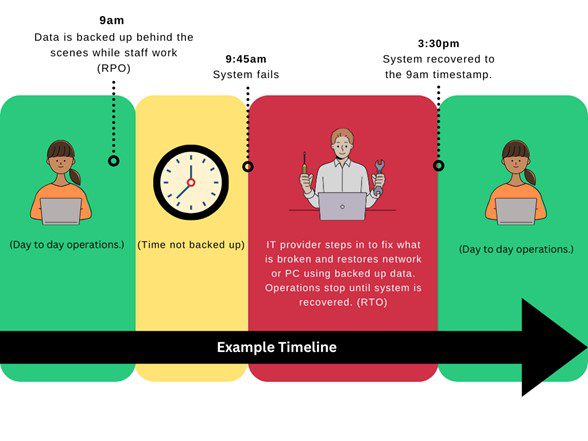When disaster strikes, knowing your RTO and RPO is crucial. Understanding these are key to ensuring your business can recover efficiently and minimize downtime.
Both are at the heart of disaster recovery and business continuity planning. Put simply:
- RTO = How long you can afford to be down.
- RPO = How much data you can afford to lose.
Understanding these two concepts helps businesses minimize downtime, reduce data loss, and avoid costly disruptions.
What is RTO?
RTO stands for Recovery Time Objective. It measures the maximum time it should take to get your systems, applications, and data back up and running after an outage.
- Typically measured in hours or days.
- Directly impacts customer service, productivity, and revenue.
- The shorter the RTO, the faster your business returns to normal.
Think of RTO as the stopwatch ticking from the moment your systems fail until operations are fully back to normal.
What is RPO?
RPO stands for Recovery Point Objective. It measures the maximum amount of data your business can tolerate losing.
- Usually measured in hours or minutes.
- Determines how often backups should be taken.
- A shorter RPO means less lost work if systems fail.
Example: If your RPO is 1 hour and a server crashes at 9:58 AM, you can restore data from 9:00 AM. Any work done after 9:00 AM will be gone.

RTO vs RPO: Key Difference
Many people say “RTO vs RPO,” but it’s not an either/or decision. Both work together:
- RTO = Downtime tolerance.
- RPO = Data loss tolerance.
Finding the right balance for your business involves understanding compliance needs, and your tolerance for downtime or data loss. Tailor your strategy for optimal results.
Building a Disaster Recovery Plan Around RTO and RPO
When creating a Disaster Recovery Plan (DRP), businesses should:
- Prioritize critical systems. Financial software (like QuickBooks), CAD/CNC programs, medical technologies, or line-of-business applications often require the fastest recovery.
- Segment backups. Large storage drives take longer to restore. Critical apps should be separated for faster recovery.
- Set different backup schedules. Consider your data needs. Infrequent files might need weekly backups, while active databases could require hourly or even minute-by-minute backups.
- Account for compliance. Regulatory requirements might require stronger RTO and RPO goals to avoid legal or financial penalties.
Strategies to Achieve Effective RTO and RPO
Meeting recovery goals requires a combination of planning, technology, and expertise:
- Prioritize systems and data. Know what’s mission-critical.
- Implement redundancy. Use cloud backups, off-site data centers, and backup servers.
- Test regularly. Run disaster recovery drills to find gaps before real disasters hit.
- Invest in reliable technology. Keep hardware, software, and networks up-to-date.
- Educate and train staff. Ensure employees know what to do during downtime.
- Monitor and update plans. Review RTO and RPO goals as your business grows.
- Consider outsourcing. A trusted Managed Service Provider (MSP) can guide you with designing and managing your disaster recovery plan.
Why RTO and RPO Protect Your Business
Ignoring RTO and RPO can lead to:
- Financial losses from downtime.
- Angry customers who can’t access services.
- Damage to your company’s reputation.
With the right plan in place, you can protect your data, your employees, customers, and business reputation.
Partner with Experts in Disaster Recovery
At 4BIS Cyber Security, we’ve spent over 30 years helping businesses design recovery plans that work. We specialize in balancing minimal downtime, minimal data loss, and cost efficiency. So, you can focus on running your business with peace of mind.
Contact us to discuss what data strategies would work best for your company.

